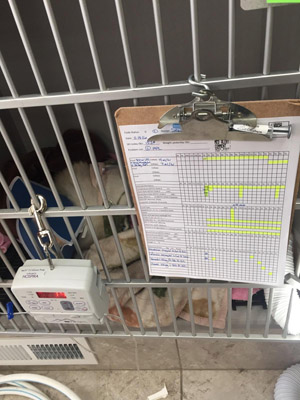ICU chart Statz

Photo by Dr. Gretchen Statz
Veterinary school is far from a war zone or prison, but it does have an attendant suite of stresses and mental challenges, not to mention tragedies. Every veterinary student must face them at some point, and they must do so without the counsel of years that have helped veterinarians learn how to handle the pressure more effectively.
In addition to normalizing or leveling of experience, gallows humor sometimes plays a role in coping with the extremes of the human condition. Both of these coping mechanisms – normalizing extremes and using humor as a defense mechanism - came into play during what I’ve come to think of as the trainwreck incident.
On an otherwise unremarkable day in the ICU of the Purdue University School of Veterinary Medicine, where I worked at the time, I walked through the ward checking each chart and getting to know the patients. There was the usual mix of trauma, cancer, organ failure, and yet-to be diagnosed maladies. It had been a particularly busy time of the year, and the tension level was quite high.
One of the charts hanging on a cage caught my eye: that of an older terrier mix who had a long list of problems and no firm diagnosis. The tiny guy was vomiting, had low protein in his blood, had lost weight, and wasn’t interested in food. He didn’t look good either, sitting mopishly in his ICU cage, eyes matted with green discharge and fur coming out in patches. Clearly the years and illness had taken their toll and not been kind to this poor unfortunate.
I read his chart.
An ICU chart lists the medications a patient is on, when they should be taken, and at what dose. Vital parameters like blood pressure and temperature are also recorded. At the top is the patient’s identifying information and a list of problems as well as the diagnosis, if we’re lucky enough to have one. It is a key part of a patient’s care, coordinating communication and results between the healthcare team. It’s also, should the need arise, a legal document if a case ever goes to court or before a state board. It’s not something that we take lightly.
I’m as likely as the next guy to use humor to defuse a tense situation, and have at times gotten myself in trouble with an ill-timed joke. But the ICU chart is never a place where humor should lay its shaggy head. For this reason, I was aghast (or perhaps agog) when I looked at the line that usually lists the diagnosis and saw only one word: trainwreck. Not hepatitis or inflammatory bowel disease or heart failure or even our shorthand for “we have no idea what’s going on” - open. Just trainwreck.
I stood there in the middle of ICU for a moment, totally gobsmacked. I felt the gears engaging in my head but the machinery refused to move.
Anger crept in. I don’t have much of a temper as a general rule, but this was just wrong. I try to always see things from both sides, walk a mile in someone’s moccasins before judgment (that way, you’re a mile ahead of them and you have their shoes) but this really got to me.
There were so many reasons to be mad: the sheer unprofessionalism, the callous disregard for a patient’s suffering, the sneering cliquishness inherent in the answer, the potential for legal liability. But I’d be lying if a part of me didn’t admit that I was mad to some degree because trainwreck didn’t tell me anything about the patient. It was an affront to the process, not to mention the patient. It didn’t help me help this dog; it didn’t decrease my workload.
People must have wondered why the usually laidback Dr. Johnson turned red and stomped out of ICU.
I don’t recall the sequence of events after that. I know that the individual who’d scrawled that word (normally a reliable and stellar student) was called to task by the administration, and that she and I also exchanged words. She was humbled, repentant, and afraid, I recall that much. Tears were shed. She came to realize that her momentary lack of good judgment had caused a ripple effect and was talked about a fair amount amongst her classmates, and would forever cast a pall over how she was viewed by faculty. She wasn’t kicked out or formally disciplined – no ‘black mark on your permanent record’ stuff. She carried on and graduated, hopefully a fine doctor who had learned a life-long lesson.
It’s a struggle in stressful or unpleasant circumstances to maintain your humanity. It’s easy to slide into the mode of the convenient label, the other-ification of those who present a challenge, are different, or are perceived as weaker. Being busy, stressed, or in emotional distress only makes that tendency stronger. By slapping the label of trainwreck on this patient, this student made the patient not into a complex problem requiring empathy and brain power but into a one-word construct, and then moved on. It was the removal of nuance.
I can see how it could happen; I’m quite sure I’ve committed the same sin myself, maybe even multiple times. When I’m in a busy hospital or dealing with more patients than I can manage, it’s easy to do.
But for doctors of any stripe, keeping our humanity and our empathy in stressful times is essential. Someday, we or one of our loved ones might be in the same position as that little terrier, and I hope that whoever is taking care of us takes the time to see an individual needing empathy and attention, not merely a problem to be easily labeled and disposed of. I don’t want to see anyone, animal or human, labeled as a trainwreck and not get the care they deserve.